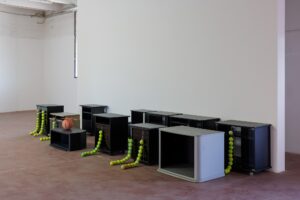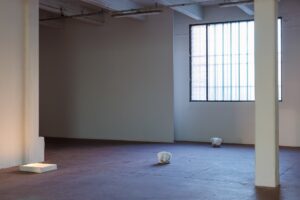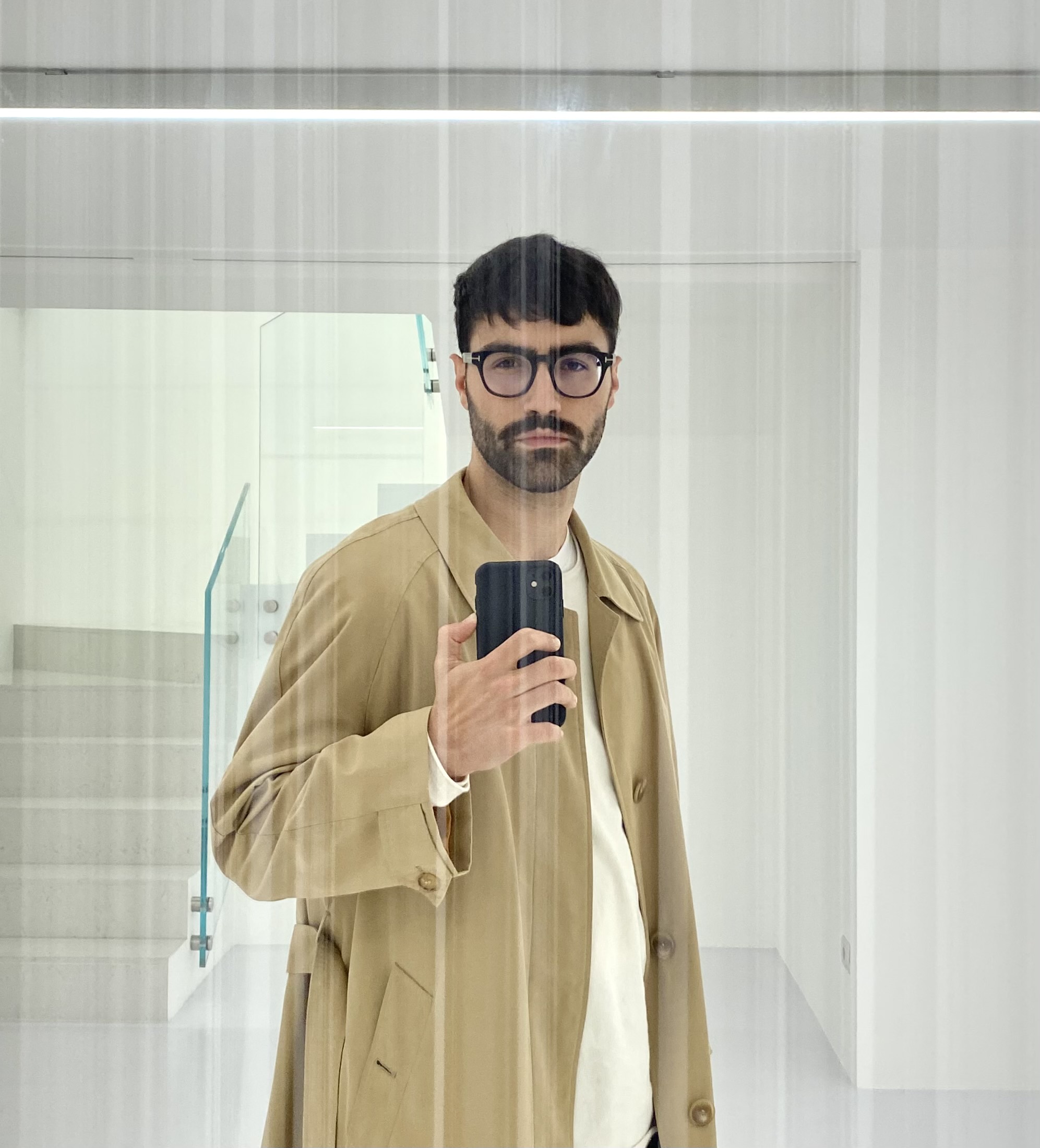Michael E. Smith works by relying completely on feelings, at the root of aesthetics as the study of perception and the senses. The artist prefers to sketch rather than define, keeping his works open and constantly evolving. What remains is a hint of incompleteness, a Michelangeloesque unfinished quality in the objects, which takes shape in space and in the relationship with the viewer..

Exhibition view, “Michael E. Smith”, ZERO…, Milan, 2023, ph. Roberto Marossi, courtesy the artist and ZERO…, Milan
Smith seeks a dialogue with the unconscious and the possible, in which organic and inorganic merge through the assembly and use of found objects. Static and inactive ready mades are displayed in the gallery, united in their quest for life. These are all used materials, furniture, scraps such as shoeboxes, chairs, work tools, industrial products like fake green lawns, transparent plastic layers, or the usual basketballs and tennis balls, as well as natural elements like starfish or derivatives like rabbit fur. From the inhuman essence an organic construction of new fluid and surreal identities emerges. These new forms do not attempt to come to life on the canvas as we can see in many monstrous encrustations in today’s paintings, but they activate themselves in space and in relation to it. It is the viewer who, by engaging himself in relationships, creates these connections. The concept of multiverse emerges in this artistic practice where anything can be anything, but the actual physical space and connections that emerge are influenced by individual perceptions. This is art: an exhibition experience and a relationship between humans and the world from which feelings emerge and develop, both inside and outside of reality. Michael E. Smith does not claim that his practice is identified by an object or that it materializes on the canvas, fixing it forever, but rather he seeks the work in progress by constructing his imagination. Basketballs or tennis balls, as well as backpacks or industrial work tools assembled with organic remains or derivatives such as paws, animal bones/human skins, are Michael E. Smith, as well as the relationship of these to each other, to space, to the viewer (onsite and online). This is the direction.

Michael E. Smith, Patrick in the multiverse, 2023, mobiletto per TV, palla da basket, stelle marine, 61,5 × 89,2 × 52 cm. Installation view, “Michael E. Smith”, ZERO…, 2023, ph. Roberto Marossi, courtesy the artist and ZERO…, Milan / Patrick in the multiverse, 2023, TV stand, basketball, starfishes, 61,5 × 89,2 × 52 cm. Installation view at “Michael E. Smith”, ZERO…, 2023, ph. Roberto Marossi, courtesy the artist and ZERO…
In the exhibition, developed on two floors, we find nothing but scattered objects, at first sight appearing as forgotten or incomplete. We do not find the work we expect to see in a gallery, but we find what we expect from art: mystery and tension. Of course, the presence of objects becomes dense, and the works are there, but we are not faced with an imposing canvas of 200 x 200 cm, but with an ironic Patrick in the multiverse, with Spongebob in the form of a basketball with a starfish resting on TV cabinets from which chains of tennis balls emerge. We then find plates placed on the ground topped with basketballs and rabbit fur, and, descending to the second floor, we encounter LEDs and batteries on a cutting board, chairs, pillows and gloves covered with reflective plastic sheet, or two Nike shoe boxes full of foam, one of which was pierced by an aluminium stick, and a beautiful green lawn. Let’s surrender to the multiverse, to the multiple relationships triggered from memes and the web, but let’s shape it in reality and in the works. Irony is critical and art is art criticism.

Exhibition view, “Michael E. Smith”, ZERO…, Milan, 2023, ph. Roberto Marossi, courtesy the artist and ZERO…, Milan
The artist not only seeks these relationships but raises to the meta-artistic level. The exhibition, in fact, has an additional characteristic that is actually the basis of all those mentioned before. It is constructed by the artist’s assistant, gallery assistants, and installers. Nothing new so far. Then why sublimate the figure of the artist and the curator when the objects find their place and form in the construction of the exhibition itself? This is what artists have been asking for decades, and this is what Smith continues to do with his work. But let’s get to the practical.The furniture at the beginning of the exhibition, for example. Why are they there? Were they developed and designed by the artist in an planning sketch? No. Were they arranged by an unconscious and deep will of the artist? No. They are there because Smith asked to buy furniture to create works and when the assistants brought them to the gallery and leaned them against a wall, ready to be moved according to the artist’s instructions, he thanked them and left the works as they were because they had found their position through chance. Similarly, the plastic sheets on the chairs, the glove, or the green grass in the basement corner. The artist catches and selects.

Exhibition view, “Michael E. Smith”, ZERO…, Milan, 2023, ph. Roberto Marossi, courtesy the artist and ZERO…, Milan
Let’s consider another example regarding the importance of the artist’s assistant. As we know, great artists usually have one or more assistants, who are often artists themselves. These assistants create works and exhibitions for the artist, buy tools and materials, move for them, and so on. So why then is this never mentioned? Certainly because they are auxiliary to the main artist, they are often young artists in process of training and are not as well known. But this doesn’t sit well with Smith. Jesse Sullivan, his assistant, is part of his work, and his works are part of the exhibition, as it can be seen on the first floor with fabrics and pins or lights, and on the second floor with a painting. So, we are facing a form of critical and experimental meta-art that is often missing in today’s art and which the artist in this case elevates to prominence. Michael E. Smith, already a familiar figure in museums and collections, still offers us a void to fill, a stimulus for artistic exploration of senses and space, as well as the future, against the bulimic brushstroke on canvas that has been a trend for some time.
Matteo Giovanelli
Info:
Michael E. Smith
20/09/2023 – 18/11/2023
Galleria Zero
Via Carlo Boncompagni 44, 20139, Milano

Matteo Giovanelli (Brescia, 1999) is an art historian. He holds a Bachelor’s degree in Cultural Heritage from the University of Verona where he pursued a Master’s degree in Arts. With a background rich in academic study and practical experience he collaborates with contemporary art galleries, navigating various curatorial environments, from galleries exhibitions to museums and fairs.






NO COMMENT